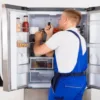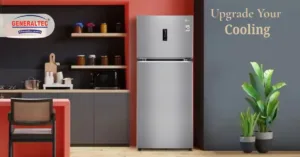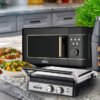Ice Maker Troubleshooting: How To Fix An Ice Maker
Ice Maker Troubleshooting
The time of filling ice cube trays and waiting for them to freeze has gone. In this modern time, everyone is in a hurry and wants very quick access to their needs and comfort. An ice maker that is not working properly can be a real headache, especially in summer when you need ice the most. Sometimes it’s frustrating to figure out what went wrong. The good news is that most of the ice maker problems are common and can be easily fixed at home with a little guidance. In this article, we will talk about the most common ice maker issues, what causes them, and how you can fix them.
Why Is Your Ice Maker Not Making Ice?
Ice will not form if the freezer temperature is above 10°F (-12°C). Set the freezer temperature to 0°F (-18°C) for best performance. Also, check door seals to ensure cold air isn’t escaping.
A defective inlet valve won’t allow water into the ice mold. Use a multimeter to test the valve for continuity. If the valve is faulty or not opening properly, it needs to be replaced.
If the water supply line is clogged with mineral deposits or something else, water won’t reach the ice maker. Disconnect the line, flush it with water, and straighten any bends.
Sometimes the issue is simple, and the power switch is turned off. Make sure that your ice maker is turned “on.”
Why Is Your Ice Maker Too Noisy?
A sound when the water valve tries to open without enough water pressure is also common. Check the household water pressure; it should be at least 20 psi for proper ice maker operation.
Loud sounds can be caused by vibration due to loose screws. Tighten all connections around the ice maker assembly and make sure the unit is level.
If you hear constant buzzing, the motor or fan may be failing. This often requires part replacement. Use a multimeter to test the motor if you think it’s not spinning properly.
Sometimes, partially frozen ice blocks the ejector arm. This can cause a clicking or grinding sound. Remove the bin and carefully check and clear the arm.
Why Are The Ice Cubes Too Small Or Hollow?
An old or dirty water filter reduces water flow, which results in small cubes. Replace the filter every 6 months or earlier if you notice changes in ice quality
Inadequate water pressure from the main supply will not allow the mold to fill properly. Ensure the pressure is at least 20–40 psi. You can use a water pressure gauge to check it
If the fill tube partially freezes, water won’t reach the mold in full volume. Use a hair dryer to thaw the tube carefully, and check the freezer temperature to prevent refreezing.
A weak or inconsistent inlet valve can reduce the amount of water entering the tray. Test the valve electrically and replace it if needed.
Why Do The Ice Cubes Taste Or Smell Bad?
Over time, algae can grow in the ice bin. Wash the bin regularly with warm water and detergent, and dry it before replacing it.
Sometimes the problem lies in the tap water supply. If your home has hard water or old pipes, install an inline water filter to improve water quality
Strong-smelling foods stored uncovered in the freezer can affect the ice’s taste. Keep food in covered containers and clean the freezer monthly using baking soda or vinegar.
Old filters can hold bacteria and impurities, causing a bad taste. Change your water filter every 6 months as part of routine maintenance.
Why Is There A Leakage Of Water From Your Ice Maker?
If the fill tube is not placed correctly, water can spray outside the mold. Adjust the tube and make sure the water flows directly into the tray.
Check the inlet hose and all connection points behind the fridge. Tighten any loose fittings and replace cracked or leaking hoses
A malfunctioning valve can leak even when closed. Check for mineral buildup around the valve and replace it if the leak does not stop.
If the ice mold is overfilled or jammed, it may cause water to spill. Clear any jammed ice, and make sure the ice maker shuts off after the tray fills.
Why Is The Ice Maker Producing Ice Too Slowly?
Make sure to set your freezer to 0°F (-18°C) for proper ice formation. If the temperature is above 10°F, ice will take longer to freeze.
Restricted water flow from an old filter means less water per cycle. Replace filters every 6 months to maintain full water pressure.
Weak water flow delays tray filling. Test your water pressure and adjust the supply if needed.
An old water valve or sensor can delay the ice-making cycle. Check these parts and replace them if they test faulty.
Ice Maker Maintenance Tips
To keep your ice maker in perfect working condition:
- Change the water filter every 6 months to maintain clean water and strong pressure.
- Clean the ice bin and ice maker parts regularly with warm and soapy water.
- Check and flush the water line at least once a year to remove any buildup.
- Avoid overstuffing the freezer, as blocked airflow can affect ice-making speed.
- Maintain a stable freezer temperature of 0°F (-18°C) to ensure best freezing performance
When To Consult A Professional Technician?
If your ice maker isn’t working after checking all common issues, then it’s time to call a technician.
Problems like a damaged motor, a faulty control board, or internal wiring issues need special tools and professional diagnosis. Delaying repairs can cause water damage or even affect the entire refrigerator’s performance.
Conclusion
A fully functional ice maker is a great convenience, especially during hot weather when cold drinks and ice are essential. But when issues arise, it can quickly become frustrating. Fortunately, most problems have clear causes and practical solutions you can try at home.
Regular maintenance—such as keeping the freezer temperature stable, ensuring proper water pressure, and preventing blockages in the fill tube or ejector arm—can help avoid many common issues.
If the problem persists even after basic troubleshooting, or if components like the motor or control board are faulty, it’s best to consult a professional technician. Generaltec is a trusted source for high quality appliances
FAQs
How Long Does An Ice Maker Take To Make Ice?
A new or reset ice maker usually takes 6–12 hours to produce the first batch. For full performance, allow 24 hours.
How Do I Reset My Ice Maker?
Press and hold the reset button (usually for 5–10 seconds) or turn the ice maker off and on. Check your manual for model-specific steps.
Why Is My Ice Maker Freezing Up?
Ice buildup happens due to leaks, overfilling, or low usage. Clear the ice bin, check the valve, and use ice regularly to prevent clumps.
Can A Power Outage Stop The Ice Maker?
Yes, a power cut can cause the ice maker to shut down or freeze unevenly. Reset it and clear any jammed ice to restore function.
Why Is My Ice Maker Turning Off On Its Own?
This may happen if the ice bin is full, the sensor is blocked, or the shut-off arm is stuck. Clean and realign the parts to fix it.
Should I Use Filtered Water In My Ice Maker?
Yes. Filtered water improves ice taste, prevents scale buildup, and protects internal components for longer performance.
Why Is The Ice Cloudy Or White Instead Of Clear?
Cloudy ice is caused by air bubbles or hard water. Use filtered water and keep the freezer temperature steady for clearer cubes.
Can I Manually Fill The Ice Tray With Water?
You can, but it’s only a temporary fix. Relying on manual filling may disrupt the automatic ice cycle or cause overflow issues.
Is My Ice Maker Affected By Cold Room Temperature?
Yes. In unheated rooms or garages, low temperatures may stop the freezer from cooling, and the ice maker will stop producing ice.
When Should I Replace My Ice Maker?
If your ice maker is over 8 years old, needs frequent repairs, or parts are hard to find, it’s better to replace the unit.














Add comment